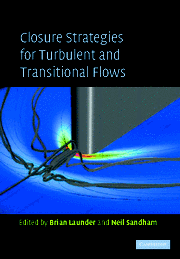15 - Higher Moment Diffusion in Stable Stratification
Published online by Cambridge University Press: 06 July 2010
Summary
Introduction
In recent years there has been intensive development of turbulence models both at the 2-equation level of modelling as well as complete second-moment closure. These models combine (relative) ease of numerical solution with sufficient accuracy for many applications. However, the use of these models to predict turbulent transport in stratified flows has given results which in some cases are even qualitatively incorrect, Lamb (1982). Both experimental and theoretical studies have identified the existence of large-scale eddy structures, LSES, in stratified flows taking the form of turbulent ‘spots’ in stable stratification and coherent structures in unstable stratification. The long lifetime of LSES results in a fluid pollutant particle being entrained by such an eddy and being transferred a considerable distance by the (LSES) without any appreciable change in its direction, see Figure 1. Thus feature does not accord with Euler's concepts of turbulence diffusion in which turbulent transport is considered analogous to Brownian motion; that is, a random-walk process. In this case a particle can travel a large distance only from multiple motions of random directions. Thus, to model turbulent transport in stratified flows where turbulent fluctuations are strongly non-isotropic, one needs to take into account the contribution of LSES corresponding to the long-wave-length part of the spectrum.
As the flow stability increases the turbulent fluctuations decrease in intensity due to destruction of the LSES. The maximum of the energy spectrum moves to smaller scales (higher wave number), see Figure 2, and the upper limit of the interval range (κη ≈ 1/η) shifts to the region of larger scales (smaller κ). This leads to a reduction in and finally to the disappearance of the inertial range (due to the merging of the dissipation and energy containing ranges). As a result, the influence of spatially non-local turbulent transport (large-distance transport by the action of LSES) in the flow dynamics becomes weak while non-local (memory) effects, which are affected by the intermittency of turbulence, increase in importance. This means that gradient-diffusion models of turbulent transport (which correctly describe transport by eddies in the inertial range having a Gaussian PDF) become inaccurate since memory effects can only be taken account of through differential equations for the turbulenttransport itself. For the case considered practically the whole energy spectrum exhibits a strongly non-Gaussian distribution. This feature has been informed by measurements in the atmospheric boundary layer (ABL).
- Type
- Chapter
- Information
- Closure Strategies for Turbulent and Transitional Flows , pp. 424 - 448Publisher: Cambridge University PressPrint publication year: 2002
- 13
- Cited by



